8 Living Fence Examples & 8 Reasons for Natural Fencing
Author: Jen Worst | Editor: Omar Alonso
Review & Research: Jen Worst & Chris Miller

A living fence brings forth thoughts of fantasy landscapes, eco-conscious livelihood, and is simply awesome to look at once they're in place and mature.
From the time man started cultivating his own food, fences have been used to keep out animals, separate different crops, and mark off private property. Traditionally, living plants have been used as fencing in many African countries and countries like India and Brazil.
Conservation is the need of the hour, and living fences offer a versatile and sustainable alternative to manufactured fences.
With natural fencing, instead of cutting down trees to make materials for building fences, we can live in harmony with nature by planting more trees and shrubs.
These fences have started gaining popularity because they offer a host of benefits apart from privacy and protection. If you can eat the cake and have it too, why would you choose not to?
8 Living Fence Examples & Reasons To Build One
Here are eight reasons why you should chuck that manufactured fence and start building a living, breathing fence. Growing them requires some knowledge, especially with training plants to grow in certain directions and understanding how to prune them and what not to do.
Living Fences are Cheaper Than Manufactured Fencing
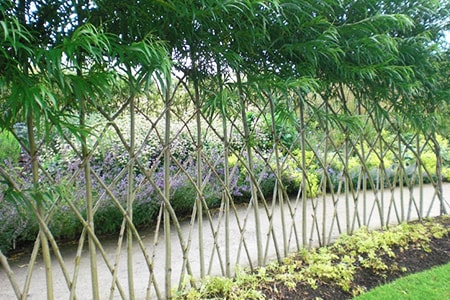
Living fences serve all the functions of a manufactured fence at a fraction of the cost. If you choose to build one of these, you can save the money spent on all of the fencing materials and instead grow them.
Apart from providing visual privacy from neighbors and controlling the movements of animals and people across property lines, like manufactured fencing, a living fence provides shade and filters noise and dust from roads and other properties.
You'll have to keep spending money on the maintenance of your manufactured fence for painting, repairing, and replacing broken or rotten sections, but not with natural fencing.
While growing and pruning a natural fence is time consuming, you don’t have to spend any extra money on maintenance once you acquire the tools that you probably already have. You don't need to worry about your gate latch types, hinges, and screws rusting.
The initial investment in seeds and saplings is the only major expense involved in the construction of a living fence, and that's pretty cheap as it is.
You can also propagate these plants using cuttings or seeds from plants you already have to save even more money!
Natural Fencing Supports Ecological Diversity
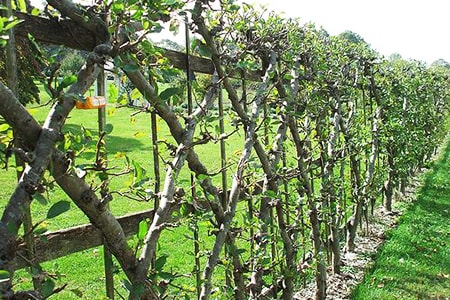
There are two kinds of natural fences: live fence posts and live barriers or types of hedges. Live fence posts use plants as fence posts to support other fencing material.
Live barriers on the other hand are completely made up of trees or shrubs that are planted without much spacing between them along the property lines.
Whatever type you choose, live fences support ecological diversity. They create a micro-ecosystem where other insects and small animals can build their homes.
Natural fences encourage the conservation of local biodiversity in the area. They bring in bees, increase pollination, and in turn increase yields in your garden or farm.
They can protect you from interlopers and provide a habitat for beneficial, indigenous organisms at the same time.
A Natural Fence is Sustainable & Durable
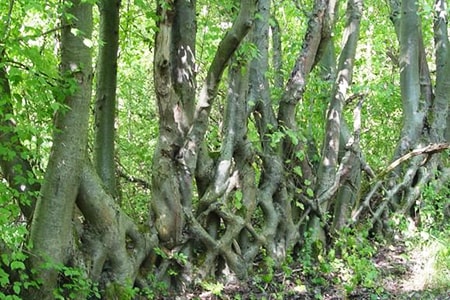
Living fences are permanent investments that last way longer than manufactured fences. A living privacy fence lasts as long as the lifespan of species that you have chosen which means it could easily be hundreds of years before you even need to think about rebuilding or replacing yours.
By regularly pruning your natural privacy fence, you can encourage new growth and renew the plants for years to come, and even harvest fruit and vegetables from them.
A natural plant fence, unlike manufactured fences, resist all types of termites and fungal attacks making them more durable in the long run.
They are also less harmful to the environment. Apart from all the regular functions of a fence, they can also end up providing fuelwood, fodder, and food. Its versatility makes it a sustainable alternative to regular fences.
A Living Fence Brightens up the Landscape
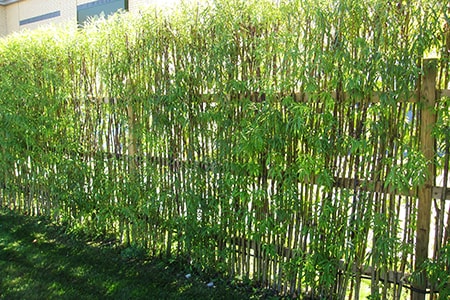
A natural tree fence with its bright green foliage, seasonal flowers, and fruits will brighten up your landscape than boring old types of wood fences.
These are used in gardens not just for privacy but also for decorative purposes. Some of the common plant varieties are chosen for a living fence to spruce up landscapes because of their ornamental qualities are cactus, various types of bamboo, types of boxwood shrubs, and privet.
When different plant species are planted side by side to form a living hedge you can even inosculate the trees or shrubs to create a different look. Inosculation refers to the tying up of crossing branches so that they graft together naturally and grow as one.
Living Fences Bring Natural Pest Control
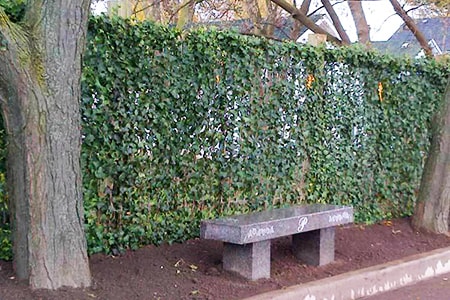
The small animals and insects that make their home in the micro-ecosystem of the fence are also great at keeping out harmful pests and rodents.
More often than not, these other organisms might be natural enemies of the common pests and animals that attack your livestock and crops.
A natural plant fence will help control infestations, thereby increasing the yield from your land.
A Living Fence Acts as Windbreak
Another great reason to build a this type of fence is that they act as barriers to reduce and redirect wind. Too much wind can stress out your livestock and crops and reduce the yield you get from them.
When the force of wind increases it also causes the soil to dry out. Your land will retain more moisture and this will enable you to cut down on the amount of water used for irrigation.
Though you will need to water the fence as it grows. If you can rig up one of the alternatives to underground sprinkler systems, you won't even need to manually water the fence.
Soil can also erode or blow away due to heavy winds. A living fence will combat soil erosion caused by wind by reducing the strength of the gusts.
By redirecting wind, these fences shield buildings from snow and also offer protection from heat and cold. This will considerably reduce the money and effort spent on heating or cooling your homes.
A Living Fence Enriches & Strengthens the Soil
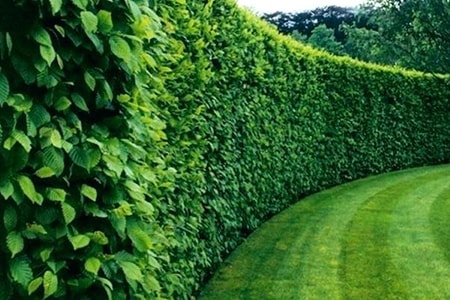
There are so many different plant varieties that you can choose from to build a living fence and each benefits your soil in different ways.
The roots of your fence bind the soil, keeping it intact and reducing soil erosion. This means that planting a fence on slopes will greatly reduce the erosion caused by rainfall.
The leaves and twigs falling off of the fence plants and decomposing on the ground create soil humus. Humus increases the fertility of the soil. It improves the permeability of the soil and this loosening of soil makes sure that water and oxygen can reach plant roots easily.
Leguminous fence plants add nitrogen to the soil. The bacteria that live in the root nodules of these plants are capable of converting atmospheric nitrogen into forms of nitrogen that can be absorbed and utilized by plants.
The leaves of such leguminous plants are also rich in nitrogen and can be effectively used for mulching plants that require that extra dose of nitrogen.
Natural Fences are a Source of Food & Fodder
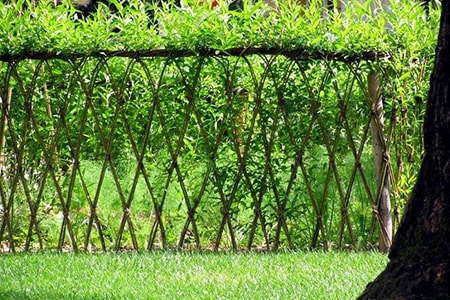
Apart from providing all the functions of a manufactured fence, there are also a lot of additional benefits that you can reap from building a natural fence. Depending on the climate and the purpose for which you have built your fence, you'll choose different plant species.
Most of the commonly used fence plants also end up being sources of food, fodder, and wood along with offering privacy and protection. The foliage of many fence plants can be consumed by both humans and animals. Some plants even produce fruits and berries.
The wood from the fence plants is used as firewood or for small woodworking projects. And dead leaves from most plants can be used for mulching and composting.
Osage orange, also known as hedge apple or horse apple, is one of the most commonly used plants for natural fences in America. The thorns deter deer and other animals from getting too close.
These plants are easy to propagate from seeds, cuttings, or sprouts from roots. They're also highly adaptable in many soils and are drought resistant.
Their long lifespan and low risk of pest infestation make them an ideal choice for living fences. Although the fruit from the tree is not fit for human consumption, squirrels do feed on the fruit seeds.
Hawthorns are another popular choice. These small trees with stout thorns keep out trespassers. They also produce edible berries and have some medicinal uses. Their wood is also used as fuel. Nothing goes to waste with these fences.
How to Make a Living Fence
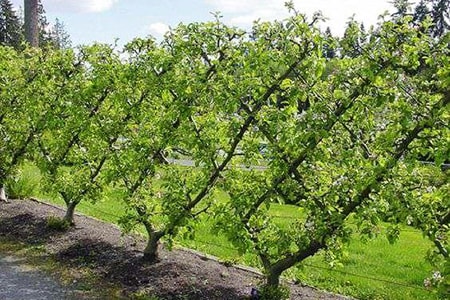
No matter if you start from seeds or transplant established saplings, plant the trees, shrubs, or edible berry bushes somewhere between 4 and 8 inches apart. You can then inosculate them by bending their pliant trunks together.
Pulling each one over, past the next one, and staking it to the ground will ensure the main trunks thicken and stay that way. The branches will then grow upwards creating a much more dense fence that you'd get otherwise.
You can then keep the bottoms clear of foliage for easy watering and fertilizing, which also lets small animals like squirrels and rabbits pass through. I would recommend not using any bushes that contain thorns on their branches for this reason.
As the branches grow skyward, you can return to them and weave them into any pattern you like. This can be for decoration, especially with trees, or for density with shrubs.
You can also opt to use lattice fencing and grow vines or climbing vegetables to fill in the gaps. The only problem is you won't be able to easily reach the other side. You can consider using flowers like roses, but make sure you know how to prune roses and remember that the thorns will be present.
Living Fence for a Sustainable Future
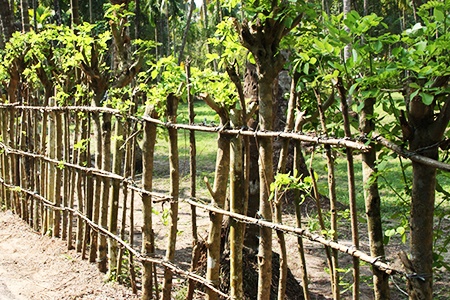
Looking after living beings is definitely going to be way more difficult and time consuming than looking after non-living things. The same goes for a living fence.
You have to put in a lot of effort, especially during the growing stages, to set up a strong and lasting natural fence. After that, it takes no more effort that trimming shrubs.
If you have quite a lot of property to fence in, this might be a very labor-intensive task. Not only will you need to plant lots of saplings close together over the entire boundary, but you will also have to water and fertilize the fence until it spreads out enough roots to fend for itself.
Once the fence has matured, you will also need to regularly prune the branches to keep it thick, bushy and impenetrable. Moreover, healthy plants can encroach on your neighbor’s property which might cause some spats in the future.
But all good things take time and the benefits that you will reap from a natural fence make up for the time and effort spent on keeping it healthy and strong. Build a living fence. We can plant trees instead of cutting them down.



